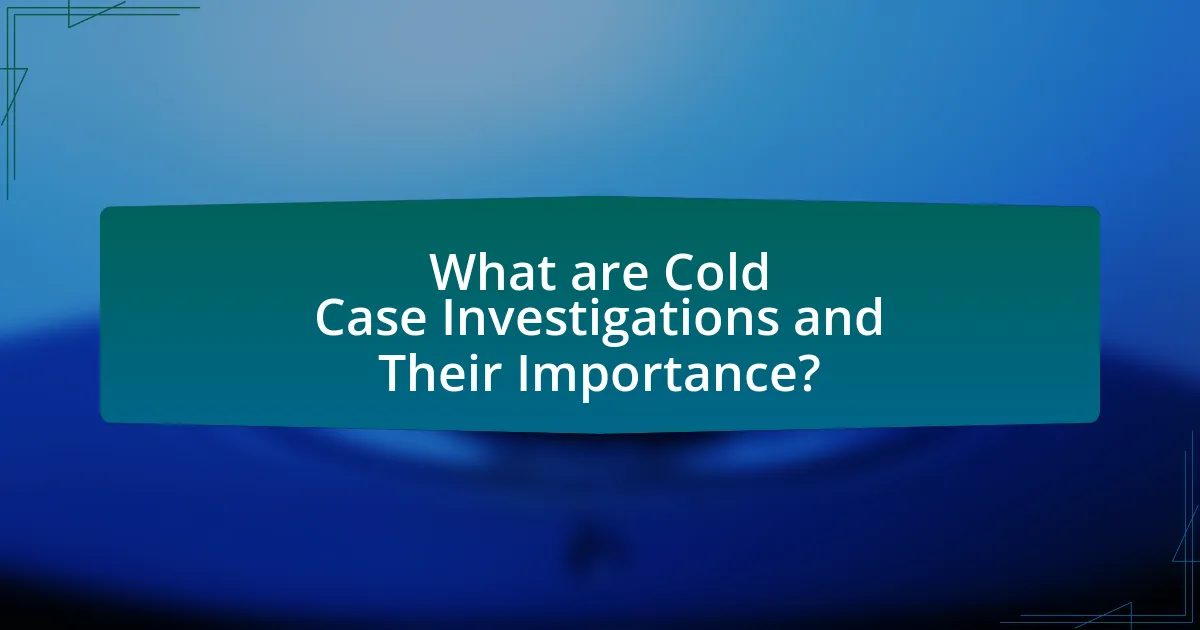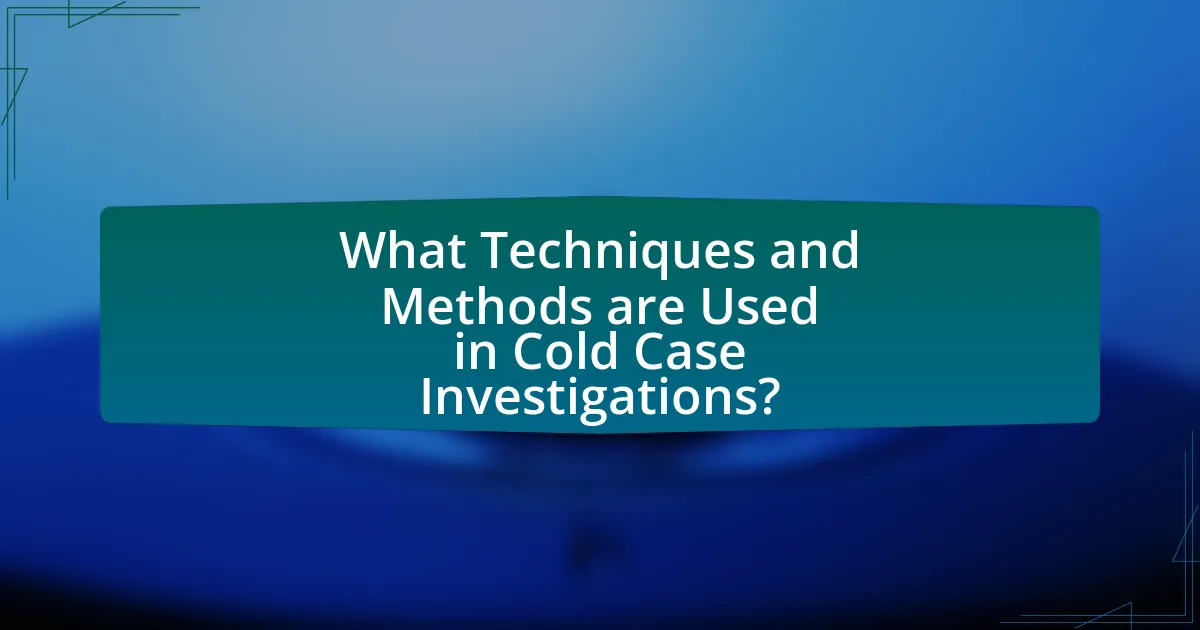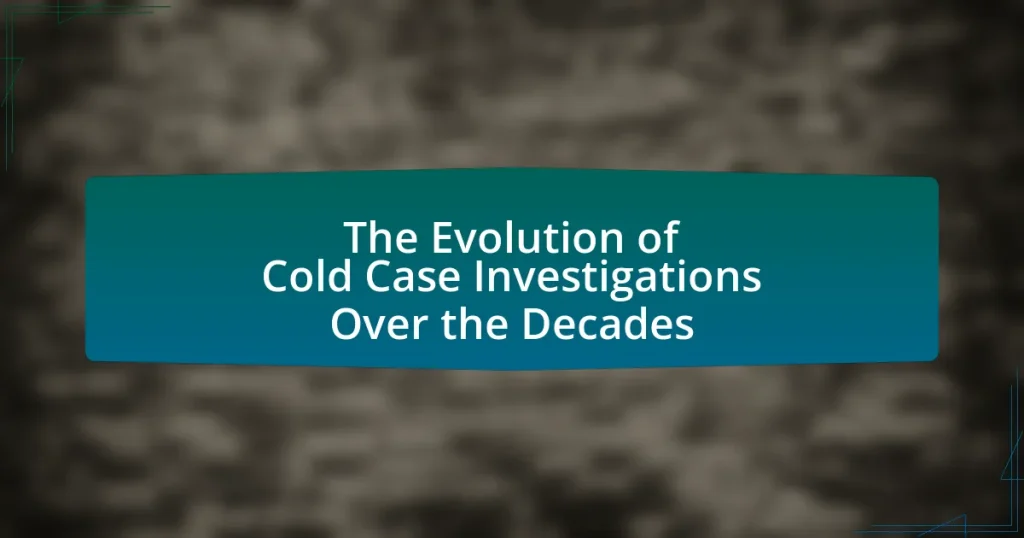Cold case investigations refer to inquiries into unsolved criminal cases that remain open after all leads have been exhausted. The article explores the evolution of these investigations over the decades, highlighting advancements in forensic technology, such as DNA analysis and digital databases, which have significantly improved the resolution of previously unsolvable cases. It discusses the historical events that influenced the development of cold case units, the impact of technology on investigative methods, and the challenges faced by investigators. Additionally, the article examines the role of public interest, community efforts, and best practices in enhancing cold case investigations, ultimately emphasizing their importance in the criminal justice system and the pursuit of justice for victims and their families.

What are Cold Case Investigations and Their Importance?
Cold case investigations are inquiries into unsolved criminal cases that remain open after all leads have been exhausted. Their importance lies in the potential to bring justice to victims and closure to families, as advancements in forensic technology and investigative techniques can reopen cases that were previously deemed unsolvable. For instance, the use of DNA analysis has led to the resolution of numerous cold cases, highlighting the ongoing relevance of these investigations in the pursuit of justice.
How have Cold Case Investigations evolved over the decades?
Cold case investigations have evolved significantly over the decades, primarily due to advancements in forensic science, technology, and investigative techniques. In the 1970s and 1980s, cold cases were often limited by the lack of sophisticated forensic methods, relying heavily on witness testimonies and physical evidence that could degrade over time. By the 1990s, the introduction of DNA profiling revolutionized cold case investigations, allowing law enforcement to re-examine evidence with greater accuracy and link suspects to crimes more effectively.
In the 2000s, the integration of digital databases and online resources facilitated the sharing of information across jurisdictions, enhancing collaboration among law enforcement agencies. Additionally, the rise of social media and public interest in unsolved cases has led to increased pressure on authorities to revisit cold cases, often resulting in renewed investigations. Recent years have seen the application of advanced technologies such as genetic genealogy, which has successfully solved numerous cold cases by identifying suspects through familial DNA connections.
These advancements demonstrate a clear trajectory in cold case investigations from reliance on traditional methods to the incorporation of cutting-edge technology, significantly improving the chances of solving previously unsolvable cases.
What historical events influenced the development of Cold Case Investigations?
The development of Cold Case Investigations was significantly influenced by the establishment of forensic science in the mid-20th century, particularly the introduction of DNA analysis in the 1980s. This advancement allowed law enforcement to revisit unsolved cases with new scientific methods, leading to the resolution of previously stagnant investigations. Additionally, the rise of the “Innocence Project” in the 1990s highlighted wrongful convictions, prompting a reevaluation of cold cases and the importance of thorough investigative practices. These events collectively contributed to the formalization and growth of cold case units within police departments, enhancing their ability to solve long-standing mysteries.
How has technology impacted Cold Case Investigations?
Technology has significantly enhanced cold case investigations by providing advanced tools for evidence analysis and data management. For instance, DNA analysis techniques, such as mitochondrial DNA testing, have allowed investigators to identify suspects and victims in cases that were previously unsolvable. Additionally, the use of digital databases, like the Combined DNA Index System (CODIS), enables law enforcement agencies to share and compare genetic information across jurisdictions, increasing the likelihood of solving cold cases. Furthermore, advancements in forensic imaging and artificial intelligence have improved the ability to analyze crime scene evidence and generate leads, making it easier to revisit and resolve long-standing cases.
Why are Cold Cases significant in the criminal justice system?
Cold cases are significant in the criminal justice system because they represent unresolved crimes that continue to impact victims’ families and communities. These cases often highlight systemic issues within law enforcement, such as resource allocation and investigative techniques. According to the FBI, approximately 250,000 homicides remain unsolved in the United States, illustrating the scale of the problem. Additionally, advancements in forensic technology, such as DNA analysis, have led to the reopening of cold cases, resulting in successful prosecutions and closure for victims’ families. This ongoing pursuit of justice underscores the importance of cold cases in ensuring accountability and maintaining public trust in the criminal justice system.
What role do Cold Cases play in solving ongoing criminal activities?
Cold cases play a significant role in solving ongoing criminal activities by providing new leads and insights that can be re-examined with modern forensic techniques. Investigators often revisit cold cases when new evidence or technology emerges, which can link past crimes to current suspects or patterns of behavior. For instance, advancements in DNA analysis have led to the resolution of cold cases that were previously unsolvable, thereby impacting ongoing investigations by identifying serial offenders. A notable example is the use of familial DNA in cold cases, which has helped solve recent crimes by connecting suspects to previously unsolved cases, demonstrating the interconnectedness of past and present criminal activities.
How do Cold Cases affect victims’ families and communities?
Cold cases significantly impact victims’ families and communities by perpetuating a sense of unresolved trauma and loss. Families often experience prolonged grief and uncertainty, as the lack of closure can hinder their ability to heal. Research indicates that unresolved cases can lead to increased anxiety and stress among family members, affecting their mental health and relationships. Communities also feel the repercussions, as cold cases can foster a climate of fear and distrust, undermining public safety and community cohesion. For instance, a study by the Bureau of Justice Statistics found that unsolved homicides can lead to a 20% increase in perceived crime rates within affected neighborhoods, illustrating the broader societal implications of cold cases.

What Techniques and Methods are Used in Cold Case Investigations?
Cold case investigations utilize various techniques and methods to solve unresolved crimes, including forensic analysis, re-examination of evidence, and advancements in technology. Forensic analysis involves the use of DNA testing, which has revolutionized the ability to link suspects to crimes, as evidenced by the exoneration of wrongfully convicted individuals through DNA evidence. Re-examination of evidence allows investigators to apply new scientific methods to old cases, often uncovering new leads. Additionally, advancements in technology, such as digital forensics and data mining, enable law enforcement to analyze vast amounts of information from social media and other digital sources, increasing the chances of finding new witnesses or leads. These methods collectively enhance the effectiveness of cold case investigations, leading to successful resolutions of previously unsolvable cases.
How do investigators approach Cold Cases differently than active cases?
Investigators approach cold cases with a focus on re-evaluating existing evidence and utilizing new technologies, unlike active cases where immediate evidence collection and witness interviews are prioritized. In cold cases, detectives often revisit old leads, analyze forensic evidence with advanced techniques such as DNA testing, and consider fresh perspectives that may have emerged over time. This method is supported by the fact that advancements in forensic science have led to the resolution of numerous cold cases, as seen in the 2018 case of the Golden State Killer, where DNA technology played a crucial role in identifying the suspect decades after the crimes were committed.
What investigative techniques are unique to Cold Case Investigations?
Unique investigative techniques in Cold Case Investigations include the use of advanced forensic technologies, such as DNA analysis and digital forensics, which were not available during the original investigation. These techniques allow investigators to re-examine evidence with modern methods, potentially identifying new leads or suspects. Additionally, cold case units often employ behavioral analysis to understand the motivations and patterns of offenders, which can provide insights into unresolved cases. The review of case files with fresh eyes by experienced detectives can also uncover overlooked details or connections to other cases. These methods have proven effective in solving cases that have remained unsolved for years, as evidenced by the increasing number of cold cases being resolved through such innovative approaches.
How do forensic advancements aid in Cold Case resolutions?
Forensic advancements significantly aid in Cold Case resolutions by providing new techniques for analyzing evidence that was previously untestable. Technologies such as DNA profiling, which became widely available in the 1980s, allow investigators to re-examine biological samples from crime scenes, leading to potential matches with suspects or victims. For instance, the use of mitochondrial DNA analysis has helped solve cases that were decades old, as it can be extracted from hair and bones where nuclear DNA is not available. Additionally, advancements in forensic imaging and digital forensics enable the reconstruction of crime scenes and the analysis of electronic evidence, which can uncover new leads. These innovations have led to a notable increase in the clearance rates of Cold Cases, with organizations like the FBI reporting that forensic breakthroughs have contributed to solving thousands of previously unsolvable cases.
What challenges do investigators face in Cold Case Investigations?
Investigators face several challenges in cold case investigations, primarily due to the passage of time, which often leads to lost evidence and fading memories. The lack of physical evidence can hinder the ability to establish new leads, while witnesses may no longer be available or may have difficulty recalling details accurately. Additionally, advancements in forensic technology can create discrepancies between old evidence and new investigative techniques, complicating the analysis. According to the FBI, approximately 6,000 cold cases remain unsolved in the United States, highlighting the persistent difficulties investigators encounter in resolving these cases.
How does the passage of time affect evidence and witness reliability?
The passage of time negatively affects both evidence and witness reliability. As time elapses, physical evidence can degrade, become contaminated, or be lost, which diminishes its value in investigations. For instance, DNA evidence can degrade over time, making it less reliable for identification purposes. Witness reliability also decreases with time due to memory decay; studies show that human memory can become less accurate as the interval from the event increases, leading to potential misidentifications or altered recollections. Research indicates that eyewitness accounts can be significantly influenced by subsequent information or stress, further complicating their reliability as time passes.
What resources are typically limited in Cold Case Investigations?
Cold case investigations typically face limitations in funding, manpower, and access to advanced forensic technology. Funding constraints often result in fewer personnel assigned to these cases, leading to slower progress. Additionally, many cold cases lack the necessary forensic evidence that modern technology could analyze, as the evidence may have degraded over time or was not collected properly initially. According to the Bureau of Justice Statistics, many law enforcement agencies report that insufficient resources hinder their ability to effectively investigate cold cases, impacting the resolution rates significantly.

What are the Recent Trends in Cold Case Investigations?
Recent trends in cold case investigations include the increased use of advanced forensic technologies, such as DNA analysis and genetic genealogy, which have significantly improved the ability to solve previously unsolvable cases. For instance, the application of familial DNA testing has led to breakthroughs in cases that have remained dormant for decades, exemplified by the identification of suspects in high-profile cases like the Golden State Killer. Additionally, law enforcement agencies are increasingly collaborating with private companies and utilizing online databases to enhance investigative efforts. This trend is supported by the National Institute of Justice, which emphasizes the importance of integrating new technologies and community engagement in solving cold cases.
How has public interest influenced Cold Case Investigations in recent years?
Public interest has significantly influenced cold case investigations in recent years by driving law enforcement agencies to allocate more resources and adopt innovative technologies. Increased public engagement, fueled by social media and true crime media, has led to heightened awareness and pressure on authorities to solve unsolved cases. For instance, the use of DNA technology has been accelerated due to public advocacy, resulting in the resolution of numerous cold cases, such as the 1986 murder of Michelle Martinko, which was solved in 2018 through genetic genealogy. This demonstrates how public interest not only raises the profile of cold cases but also directly impacts investigative strategies and outcomes.
What role do social media and crowdsourcing play in solving Cold Cases?
Social media and crowdsourcing significantly enhance the investigation of cold cases by facilitating the dissemination of information and engaging the public in the investigative process. Social media platforms allow law enforcement agencies to share details about unsolved cases widely, reaching a larger audience than traditional methods. For instance, the use of Facebook and Twitter has led to tips and leads that were previously unattainable, as seen in the case of the 1986 murder of a young girl in California, where a social media campaign revived interest and generated new leads.
Crowdsourcing further amplifies this effect by inviting the public to contribute information, share insights, and even analyze evidence collaboratively. This approach has been validated by initiatives like the “Cold Case Squad” in the UK, which utilizes online platforms to engage citizens in solving cold cases, resulting in several breakthroughs. The combination of social media outreach and crowdsourced efforts creates a dynamic environment where community involvement can lead to renewed investigations and potential resolutions of long-standing cases.
How have television shows and documentaries impacted public awareness of Cold Cases?
Television shows and documentaries have significantly increased public awareness of cold cases by bringing attention to unsolved crimes and engaging viewers in the investigative process. Programs like “Unsolved Mysteries” and “The Disappearance of Madeleine McCann” have highlighted specific cases, often leading to renewed interest and tips from the public. For instance, the airing of “The Jinx” resulted in new leads in the Robert Durst case, demonstrating how media exposure can directly influence investigations. Additionally, a 2019 study published in the Journal of Criminal Justice found that media coverage of cold cases can lead to a 20% increase in tips received by law enforcement, underscoring the effectiveness of these shows in mobilizing community involvement.
What are some notable successes in Cold Case Investigations?
Notable successes in cold case investigations include the resolution of the 1986 murder of 15-year-old Angela Blount in Florida, which was solved in 2019 through DNA evidence linking the crime to a deceased suspect. Another significant case is the 1976 murder of 19-year-old Michelle Martinko in Iowa, solved in 2018 when investigators matched DNA from the crime scene to a suspect using genetic genealogy. Additionally, the 1990 murder of 18-year-old Jennifer McKinney in California was resolved in 2019 after detectives utilized advancements in forensic technology to identify the perpetrator. These cases exemplify how modern techniques, such as DNA analysis and genetic genealogy, have led to breakthroughs in previously unsolvable cases.
Which cases have been solved due to advancements in technology?
Several high-profile cases have been solved due to advancements in technology, notably the Golden State Killer case. In 2018, law enforcement used genetic genealogy to identify Joseph DeAngelo as the suspect, leveraging DNA evidence collected from crime scenes and comparing it to public genealogy databases. This method led to his arrest and subsequent confession to multiple murders and rapes committed in California during the 1970s and 1980s. Another significant case is the 1986 murder of Michelle Martinko, which was solved in 2018 when investigators matched DNA from the crime scene to a suspect using similar genetic genealogy techniques. These advancements in forensic science and data analysis have revolutionized cold case investigations, enabling law enforcement to solve cases that had remained unsolved for decades.
How have community efforts contributed to solving Cold Cases?
Community efforts have significantly contributed to solving cold cases by fostering collaboration between law enforcement and the public, leading to new leads and information. Initiatives such as community tip lines, social media campaigns, and local awareness events have encouraged individuals to come forward with information that may have previously gone unreported. For instance, the case of the 1986 murder of 15-year-old Angela Blount in Florida was reopened after a community-led social media campaign generated new tips, ultimately leading to an arrest in 2020. Additionally, organizations like the Cold Case Foundation work to engage communities in the investigative process, providing resources and support that enhance the effectiveness of law enforcement efforts. These collaborative approaches have proven essential in revitalizing interest in unsolved cases and leveraging community knowledge to bring justice.
What best practices can be applied to Cold Case Investigations?
Best practices for cold case investigations include thorough case file reviews, re-examination of physical evidence, and utilizing modern forensic technologies. Case file reviews ensure that all available information is assessed, while re-examining physical evidence can uncover new leads or insights. The application of modern forensic technologies, such as DNA analysis and digital forensics, has proven effective in solving cases that remained unresolved for years. For instance, advancements in DNA profiling have led to the resolution of numerous cold cases, as seen in the case of the Golden State Killer, where genetic genealogy played a crucial role in identifying the suspect decades after the crimes were committed.
How can law enforcement agencies improve their Cold Case units?
Law enforcement agencies can improve their Cold Case units by implementing advanced forensic technologies and enhancing inter-agency collaboration. Utilizing DNA analysis, digital forensics, and data analytics can lead to breakthroughs in previously unsolved cases, as evidenced by the increase in solved cold cases through DNA advancements, which have led to a 20% increase in case resolutions in some jurisdictions. Additionally, fostering partnerships with other law enforcement agencies and organizations can facilitate the sharing of information and resources, thereby expanding the investigative capabilities and improving overall case management.
What strategies can families of victims employ to keep Cold Cases alive?
Families of victims can employ several strategies to keep cold cases alive, including advocating for continued media coverage, engaging with law enforcement, and utilizing social media platforms. By actively reaching out to journalists and sharing their loved one’s story, families can generate public interest and pressure authorities to revisit the case. Additionally, maintaining communication with law enforcement agencies ensures that families remain informed about any developments or new leads. Social media can serve as a powerful tool for raising awareness, as families can share updates, photos, and information that may lead to new witnesses or tips. These strategies have proven effective in various cases, as seen in the resurgence of interest in cold cases like the Golden State Killer, where public engagement played a crucial role in advancing the investigation.

